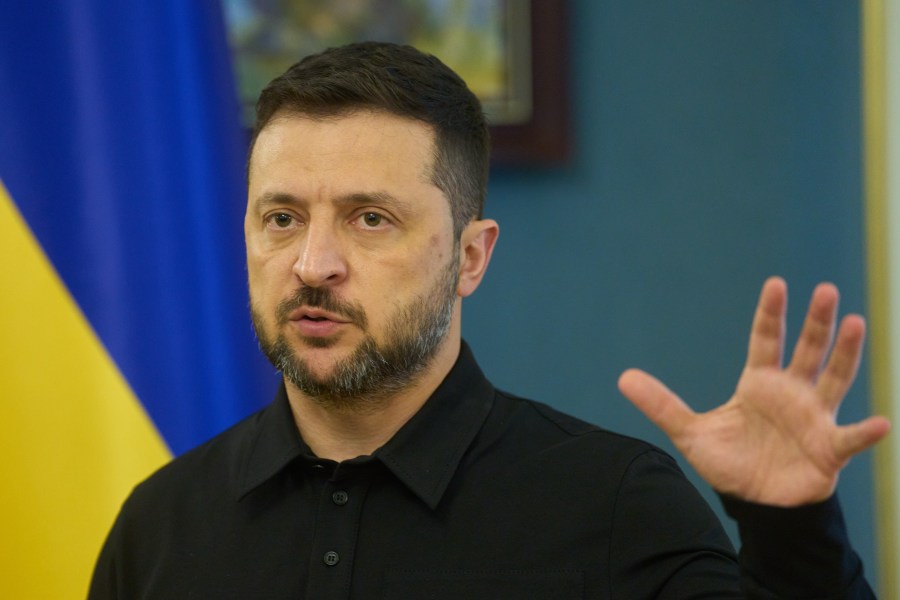World
Emergency Power Continues at Ukraine’s Zaporizhzhia Plant Amid $90B Arms Deal

Ukraine’s Zaporizhzhia nuclear power plant, located in the Russian-occupied region, has entered its fifth consecutive day of operating on emergency power. This situation raises significant safety concerns as external electricity has been cut off, according to reports from the International Atomic Energy Agency (IAEA). President Volodymyr Zelenskyy also announced a substantial $90 billion arms package with the United States, while criticizing Hungary for conducting intelligence-gathering drone activities over Ukrainian territory.
For over four days, the Zaporizhzhia nuclear power plant, which is the largest in Europe, has been reliant on emergency diesel generators after the last external power line was severed on Tuesday. Greenpeace Ukraine highlighted this interruption as a record outage for the facility, which has six reactors. The situation is particularly alarming because cooling systems powered by external electricity are essential to prevent overheating of the reactor core and used nuclear fuel, a risk that could lead to catastrophic meltdowns similar to those experienced at the Fukushima plant in Japan in 2011.
Despite a meeting between Rafael Grossi, the director general of the IAEA, and Russian President Vladimir Putin on Thursday, the external power supply was not restored. Svitlana Hrynchuk, Ukraine’s Minister of Energy, confirmed the plant remains in “blackout mode,” indicating a serious violation of operational conditions and marking the tenth such incident since Russia’s invasion in February 2022. She attributed the outage to shelling by Russian forces that damaged the critical power transmission line linking the facility to the Ukrainian energy grid.
According to a statement from a Russian-controlled Telegram channel for the plant, there are sufficient diesel fuel reserves on-site to maintain the operation of the generators for an extended period. However, Jan Vande Putte, a radiation and nuclear energy specialist at Greenpeace Ukraine, emphasized that diesel generators are the last line of defense and should only be used in extreme circumstances. He labeled the current events as the most serious since the plant’s occupation began in March 2022.
The situation is further complicated by satellite analysis indicating that Russia may be attempting to restart one of the reactors, which poses significant risks given the ongoing conflict. Reports suggest construction of power lines connecting substations in occupied cities, indicating a push to integrate the plant into the Russian-controlled energy system. Greenpeace’s analysis also noted that a new water supply system for the plant’s cooling pond has been completed, and a critical power line connecting the facility to Ukraine’s grid has been deliberately damaged. The Associated Press has not independently verified this analysis.
The city of Zaporizhzhia, located approximately 440 kilometers southeast of Kyiv, remains under Ukrainian control. Despite this, attacks have been reported in the vicinity of the plant, which is situated near the front lines of the ongoing conflict. The IAEA continues to rotate staff through the facility to monitor safety conditions and provide technical expertise.
In parallel with these developments, President Zelenskyy outlined the details of the arms agreement with the United States during a press briefing in Kyiv. He described the $90 billion package as a “mega deal,” which includes major arms and a separate agreement for the procurement of Ukrainian-made drones. Technical discussions began in late September, and Zelenskyy indicated that Ukraine has provided detailed specifications of its military requirements to U.S. officials, including requests for long-range weapon systems.
Zelenskyy also addressed tensions with Hungary, stating that Ukrainian intelligence tracked at least one Hungarian drone operating over Ukraine. He characterized these activities as “dangerous” not only for Ukraine but for Hungary as well. In response to Zelenskyy’s comments, Hungarian Foreign Minister Peter Szijjarto dismissed the claims, suggesting that the Ukrainian president was “seeing things.” Hungary, under Prime Minister Viktor Orbán, has maintained close ties with Russia and has been critical of military support to Ukraine.
Additionally, Zelenskyy revealed that an Israeli Patriot air defense system has been operational in Ukraine for the past month, with more systems expected to arrive in the fall. He declined to provide further specifics on the air defense deployments, and Israel’s Defense Ministry has not commented on the matter.
As the situation in Ukraine continues to evolve, the international community remains focused on developments at the Zaporizhzhia nuclear power plant and the broader implications of military agreements and regional tensions.
-

 Lifestyle5 months ago
Lifestyle5 months agoLibraries Challenge Rising E-Book Costs Amid Growing Demand
-

 Sports4 months ago
Sports4 months agoTyreek Hill Responds to Tua Tagovailoa’s Comments on Team Dynamics
-

 Sports4 months ago
Sports4 months agoLiverpool Secures Agreement to Sign Young Striker Will Wright
-

 Lifestyle4 months ago
Lifestyle4 months agoSave Your Split Tomatoes: Expert Tips for Gardeners
-

 Lifestyle4 months ago
Lifestyle4 months agoPrincess Beatrice’s Daughter Athena Joins Siblings at London Parade
-

 Science4 months ago
Science4 months agoSan Francisco Hosts Unique Contest to Identify “Performative Males”
-

 World4 months ago
World4 months agoWinter Storms Lash New South Wales with Snow, Flood Risks
-

 Science5 months ago
Science5 months agoTrump Administration Moves to Repeal Key Climate Regulation
-

 Business5 months ago
Business5 months agoSoFi Technologies Shares Slip 2% Following Insider Stock Sale
-

 Science5 months ago
Science5 months agoNew Tool Reveals Link Between Horse Coat Condition and Parasites
-

 Sports4 months ago
Sports4 months agoElon Musk Sculpture Travels From Utah to Yosemite National Park
-

 Science5 months ago
Science5 months agoNew Study Confirms Humans Transported Stonehenge Bluestones









